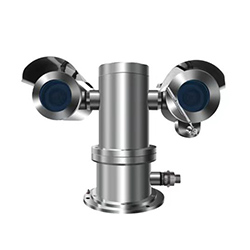QJZ3000 Scanning Type Laser Gas Remote Sensing Instrument
2023-4-19
![]()
Product Introduction
This product comprehensively adopts laser absorption spectrum detection technology, video surveillance technology, and control technology, which can perform non-contact automatic scanning monitoring of the workplace, display the concentration of methane in the workplace in real time, comprehensively monitor gas leakage situation, and locate the leakage location. The product can be fixedly installed and used at multiple locations in the workplace, and can also be used in vehicles.
Technical Indicators
|
Gas Detection |
Methane (CH4) and mixed gases containing methane |
|
Detection Principle |
Tunable laser spectroscopy analysis technology |
|
Video |
Standard definition visible light video with zoom capability |
|
Range of Measurement |
(0 ~ 50000)ppm·m |
|
Response Time |
≤0.1s |
|
Detection Distance |
0m - 150m |
|
Continuous Working Hours |
7 × 24-hour active online monitoring |
|
Scanning Range |
Horizontal:0°- 360°”,Vertical:-90°- +90° |
|
Working Voltage |
AC 220+40V |
|
Explosion Proof Grade |
ExdlIC TB Gh |
|
Protection Level |
IP68 |
|
Working Temperature and Humidity |
-40℃- +70℃,95%RH |
|
Shell Material |
Standard 304 stainless steel (optional 316L) |
|
Standardization |
Factory standardization, no need for repeated standardization |
|
Calibration |
Automatic calibration |
Functional Features
1. Laser absorption spectrum detection, sensitive, fast and accurate;
2. Non contact automatic measurement, safe and efficient;
3. Automatic scanning and monitoring, with a wide protection range;
4. Can be set up in multiple locations to meet the needs of different scenarios;
5. Standard communication protocol for easy access to networking and data exchange;
6. Real time video, the situation throughout the entire process is clear at a glance;
Application Fields
The product is suitable for workplaces that require gas leakage monitoring, such as coal and its chemical industry, petroleum and petrochemical industry, natural gas, mining, power plants, etc. It can be used for monitoring gas concentration content, inspecting gas pipeline networks, inspecting outdoor natural gas pipes, and inspecting natural gas storage tanks. Remote detection can be carried out in areas with gas leakage hazards and areas that are difficult for personnel to reach.
Typical application methods: Inspection of production facilities, mines, oil and gas pipelines, long-distance pipelines, underground pipe galleries, and other key locations in the factory area.
Anhui Lijian Defense Technology Co., Ltd Copyright 皖ICP备20002291号-1 disclaimer

